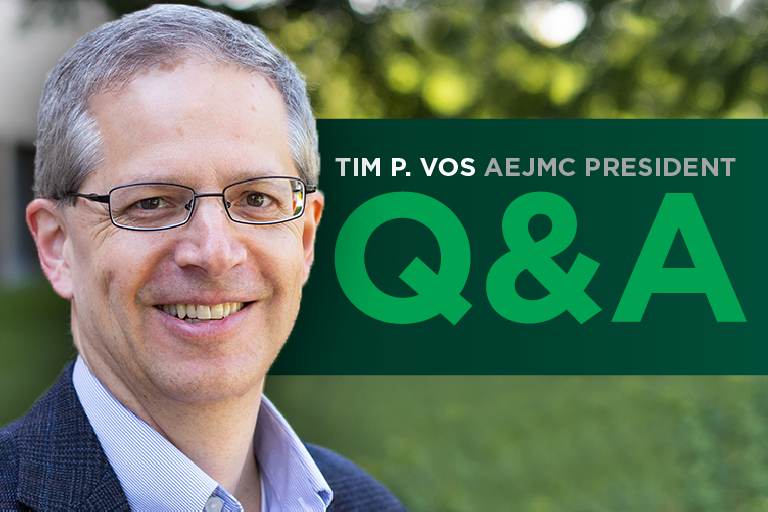ComArtSci’s Dr. Tim P. Vos, Professor and Director of the Journalism School, this year serves as President of the Association for Education in Journalism and Mass Communication (AEJMC). AEJMC is one of the world’s largest and oldest associations dedicated to research, teaching, and outreach in journalism and mass communication. The organization’s annual conference is August 4-7, 2021.
Below, Professor Vos looks back on his own history with AEJMC and offers tips for first-time conference attendees.
Where was your first AEJMC?
My first AEJMC was in Miami Beach in 2002 in the iconic Fontainebleau Hotel. I couldn’t believe my luck. A great conference in a great location.
What do you remember about your first AEJMC presentation?
Practice, practice, practice. I’d been an on-air broadcaster for over a decade and done some teaching, but I was convinced this was the most important presentation of my life. Which it clearly wasn’t. But I practiced for weeks. It went pretty well. But I probably overdid the practice.
What does the AEJMC president do during the conference?
Lots of meetings – committee meetings, business meetings, board meetings. And I chair a presidential panel. But I also just attend sessions like everyone else. I have just as much to learn from the sessions as any attendee.
What does it take to become the president of AEJMC? What was your journey to becoming president?
Well, there’s a nominations and elections committee that takes nominations from the whole membership and then they asked me if I’d like to run for election. They generally ask folks who’ve been pretty involved in the Association, and I have been. I’d chaired the History Division and I’d been elected to the Standing Committee on Research and done a bunch of other things too. So, once I said yes, I had to craft a platform of policy priorities. Then there was an election. Once elected, I was vice-president for a year, then president-elect for a year. It seems like I was vice-president a decade ago. It’s been a pretty intense experience.
What were the biggest challenges (or successes!) planning for an online conference this year?
Frankly, the biggest challenge was just deciding whether to be online or in-person. We saw so many contradictory signals. It’s a lot of work to put on a conference – whether in-person or online – but once the decision was made it was just a lot of legwork. AEJMC was online last year, of course, and there have been several other online conferences in the last year, so it wasn’t inventing something out of nothing. Which is what it felt like last year.
What is one piece of advice you’d give to junior scholars attending AEJMC for the first time?
Don’t freak yourself out preparing for your own presentations. It really is about learning from others and getting to know people who will end up being a big part of your life. So, be curious. Listen intently. Ask questions. Have intellectual fun.
What advice would you give to future leaders of AEJMC?
I’d say two things, which will sound a bit contradictory. So, one is to push for change. Big organizations such as AEJMC have a lot of built-in inertia. So, if you see something that needs to be changed or updated, push to make it happen. The other thing is to think long term. We need to get a handle on how our field – not just the professions many of us study – is changing. We need to steer it in the right directions. Because if we don’t, decisions will get made for us or we’ll condemn ourselves to irrelevance.
There are a lot of different conferences that journalism and communication scholars can attend. What makes AEJMC unique?
Lots of conferences have great research. There are even a few that take pedagogy seriously. But AEJMC is unique in that it gives full attention to research, teaching and service.
Conferences can be a great place to build relationships with other scholars and practitioners. What is a great connection you’ve made at AEJMC?
Initially, it was just connecting with graduates of the program that I was attending. I was getting my Ph.D. at the Newhouse School at Syracuse and I got connected to recent grads, such as Kim Bissell and Steve Collins, who really showed me the ropes.
Dave Weaver, who’s a former AEJMC president and a great scholar, took interest in my very first AEJMC paper and encouraged me to develop my ideas. I’m not sure I would have read his work so closely if we hadn’t connected at AEJMC, but I owe so much to his research. I'm still building on his scholarship close to two decades later.
I’m pretty sure I’d never be an AEJMC president without those relationships.
